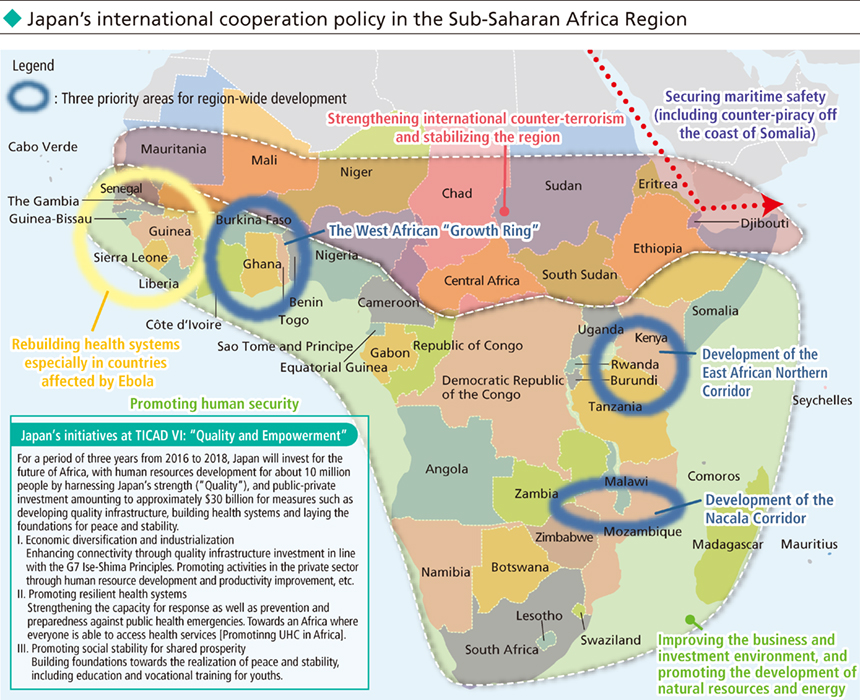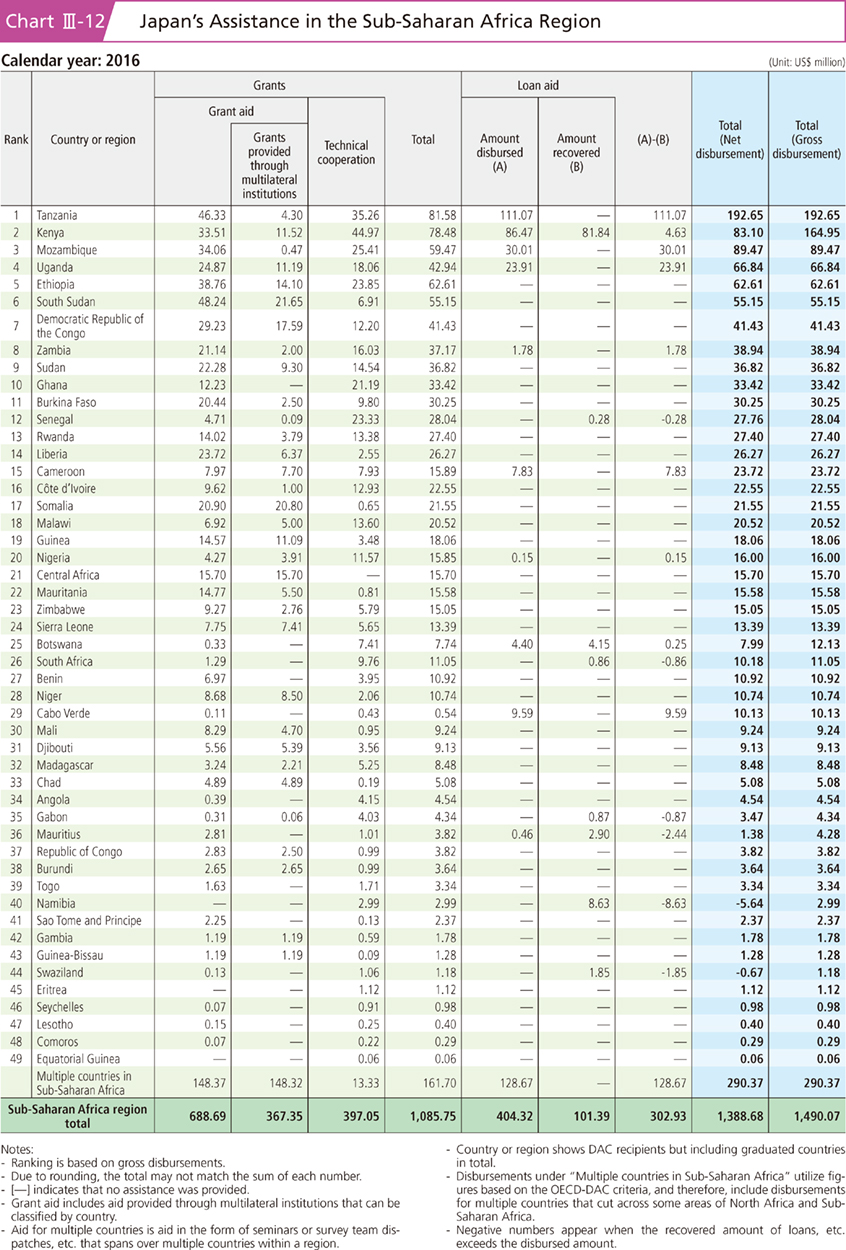5. Sub-Saharan Africa
The region of Sub-Saharan Africa, which is located in the south of the Sahara Desert, has immense potential owing to its rich natural resources and a population of 1.2 billion people. In recent years, however, it confronts new challenges including the decline in global commodity prices, a fragile health system, and the rise of terrorism and violent extremism. In response to these issues, the African Union (AU) Summit held in 2015 adopted the “Agenda 2063,” a new development agenda for Africa. In addition, during the same year, the UN newly adopted the “2030 Agenda for Sustainable Development.” As such, the international community has started to tackle the challenges by closely supporting Africa's own efforts.
<Japan's Efforts>

In December 2017, Prime Minister Abe held a summit meeting with President Macky Sall of Senegal during President Sall's visit to Japan to attend the UHC Forum 2017.

Foreign Minister Kono emphasized the importance of strengthening connectivity between Asia and Africa during the Tokyo International Conference on African Development (TICAD) Ministerial Meeting held in Mozambique in August 2017.
Cooperating with the international community, Japan co-organizes the Tokyo International Conference on African Development (TICAD) together with the United Nations, the United Nations Development Programme (UNDP), the World Bank and the African Union Commission (AUC), as a framework for supporting Africa's own efforts. TICAD VI was held in Nairobi, Kenya in 2016 for the first time in Africa. Over 11,000 people, including the representatives of 53 African countries, development partner countries, Asian countries, international and regional organizations, the private sector, NGOs and civil society participated in the conference including side events.
At TICAD VI, intensive discussions were held taking into account the changes in the environment surrounding African development after TICAD V in 2013. The themes of the discussions were: (i) Promoting structural economic transformation through economic diversification and industrialization; (ii) Promoting resilient health systems for quality of life; and (iii) Promoting social stability for shared prosperity. As the outcome of these discussions, the Nairobi Declaration, which states the direction of African development, was issued.
As a part of the TICAD VI initiatives, the Government of Japan announced that Japan would invest approximately $30 billion from the public and private sectors in total for the future of Africa, which includes human resources development for approximately 10 million people, benefitting from the strength of Japan (“Quality”), as well as the development of quality infrastructure, promotion of resilient health systems and laying the foundations for peace and stability, etc. for a period of three years from 2016 to 2018. These initiatives also include efforts to develop approximately 30,000 industrial human resources, to increase the number of people with access to basic health services by approximately 2 million people across the whole of Africa, as well as to save 300,000 lives through assistance of more than $500 million.
The TICAD Ministerial Meeting was held in Maputo, Mozambique, in August 2017. During the meeting, the delegates affirmed the progress status for commitments of TICAD V in 2013 and TICAD VI in 2016, and confirmed the implementation of more than $5 billion in support efforts since 2016, including the provision of vocational training for more than 16,000 people and educational opportunities to approximately 2.5 million people. In this respect, many African countries highly appreciated Japan's assistance. The Government of Japan also held a “Dialogue with Private Sector from Japan and Africa” as one of the side events of the Ministerial Meeting, where participants reaffirmed that the involvement of the private sector is essential to Africa's economic development.
The next TICAD 7 is scheduled to be held in Yokohama, Japan, in 2019.


•Burkina Faso
School Management Committee Support Project Phase 2
Technical cooperation project (May 2014 - December 2017)

COGES monitoring
Since 2012, Burkina Faso has been working to improve access and quality of basic education, develop non-formal education* and decentralize the education system under its 2012-2021 Development Strategy Programme of Basic Education (PDSEB2012-2021). The country is also promoting the setup of School Management Committee (COGES) led by local residents as a way to improve the learning environment amid the decentralization of education. In Burkina Faso, which has a low literacy rate of just 34.6% for its population of the age of 15 and over (2014), there are many children whose parents never attended school. To improve the quality of education, it is vital not only to improve school classrooms, but also ensure their parents and community to understand the need for education and provide support to children.
At the request of Burkina Faso, Japan carried out the technical cooperation project called the School Management Committee (COGES) Support Project from 2009 to 2013. The project established an effective COGES model and helped set up 2,780 COGES in the four provinces that served as the pilot areas.
Under the School Management Committee Support Project Phase 2 launched in May 2014, staff at partner institutions newly established at the end of Phase 1 and long-term Japanese experts worked side by side to establish 11,700 COGES with the budget of the Ministry of Education and Literacy in the remaining provinces outside the scope of Phase 1. COGES contributes to the improved quality of education through planning and implementation of activities based on the needs of their own schools, and COGES are expected to serve as a key organization of decentralization that distributes school subsidies and provides school lunches in the future.
*Any organized educational activity that takes place outside the formal educational system.
•Botswana
The Project for the Construction of Classroom Block at Serameng Primary School in Kweneng District
Grant Assistance for Grass-Roots Human Security Projects (February 2016 - February 2017)
Botswana had a population of approximately 1.32 million as of 1991, but its population had grown to approximately 2.26 million as of 2015. Serameng Primary School is a public school located in the Mogoditshane Sub District, approximately half an hour by car from the capital city of Gaborone. This district is in a commutable distance from Gaborone, yet rents and other living expenses are comparatively low. Accordingly, it is a popular area to live in among migrant workers from the rural area and is witnessing striking population growth. As a result, the school did not have enough classrooms to cope with the soaring number of children, which meant some of them were forced to line up their desks outside to study. Under these circumstances, it fell far short of a condition where the children could concentrate and learn, because lessons were affected not only by the weather, but also by the noise from the national highway that runs directly alongside the school.
The recipient organization of the project, the Mogoditshane/Thamaga Sub District Council of Kweneng, had been planning to build a classroom block but was unable to count on financial support from the local government due to a budget shortfall, and there was no prospect of it finding another source of funding either. In such circumstances, Japan provided support to the organization through the Grant Assistance for Grass-Roots Human Security Project.

Serameng Primary School children attending the handover ceremony (Photo: Reika Horio)
Construction of the classroom block began in February 2016 and was completed in February 2017. It has resulted in approximately 70 children (two classes) at Serameng Primary School being able to newly receive tuition in classrooms. In addition, classes that study outside are also taking turns using the new classrooms for periods of one week, meaning it has become possible for a total of approximately 140 children (four classes) to attend classes inside.
The population in this area is expected to continually increase in the future, and the number of young working people with primary school-aged children is predicted to increase in particular, so the classrooms are likely to continue to be utilized long into the future.
•Rwanda
The Project for Improving Mathematics Education in Primary Schools in Kimironko
JICA Partnership Program (JPP) (November 2016 - )
Improving the quality of science and mathematics education is one of the top priorities of Rwanda, a country which pursues socio-economic development through human resource development in the science and technology field. However, Rwanda faces a shortage of competent teachers because of the loss of teachers during the civil war, and the change of its medium of instruction in schools from French to English. Thus, capacity building of teachers is an urgent task for Rwanda.

A Japanese education expert demonstrating mathematics teaching methods to teachers from elementary schools in the Kimironko District of Kigali City (Photo: Think about Education in RWANDA)
Think About Education in RWANDA, a Japanese NPO, is engaged in the improvement of teaching ability in mathematics by inviting teachers of Umuco Mwiza School and education administrators from Gasabo District to Japan. During their stay, they learn the school-based in-service training known as “lesson study,” which is practiced by teachers at primary schools in Japan. After their return to Rwanda, the method is shared and practiced widely among teachers not only at Umuco Mwiza School, but also its neighboring schools, making it a model project for improving the mathematics teaching ability of teachers in Rwanda.
Furthermore, the Japanese NPO aims to promote lesson study all across Rwanda through the Rwanda Education Board, in collaboration with the “Project for Supporting Institutionalizing and Improving Quality of SBI Activity (January 2017- December 2019),” JICA's technical cooperation project. An in-school training system was introduced in Rwanda in order to familiarize a new curriculum launched in 2016, but it has confused most of the schools due to their lack of experience. Therefore, expectation is mounting for the two Japanese projects which can demonstrate specific teaching methods. Know-how in the in-school training system that supports Japanese education is spreading in Rwanda facilitated by the synergy between the two Japanese projects. (As of December 2017)
